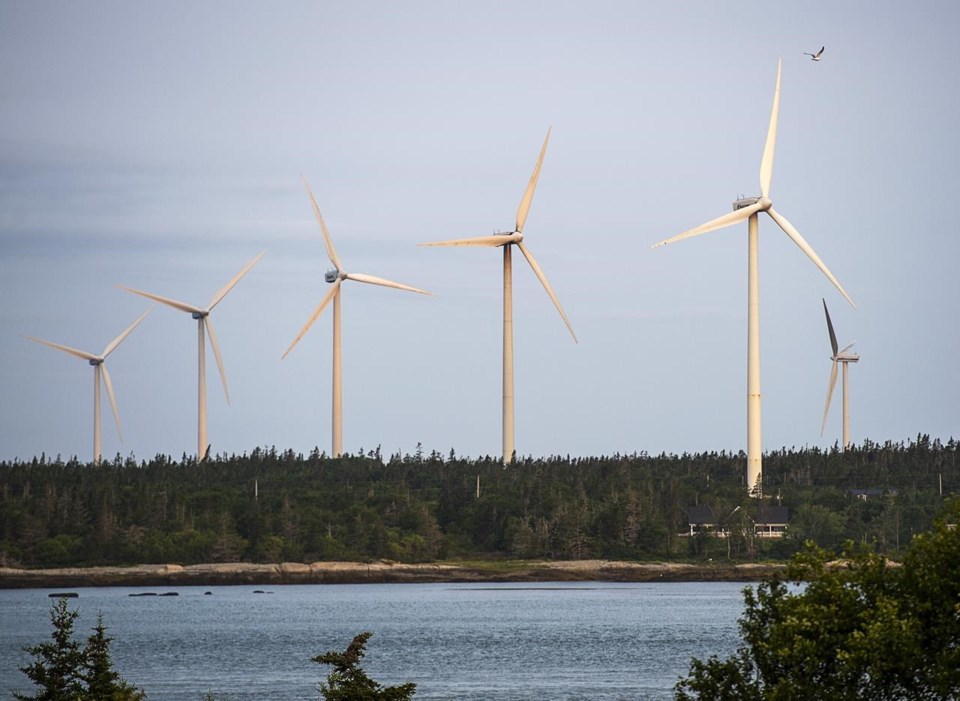CALGARY — Wind and solar operators in Canada are being urged to reduce the likelihood of catastrophic grid outages by making their infrastructure more resilient to climate change.
Renewable energy operators from across the country gathered at a conference in Calgary this week to discuss the growing risk that climate change-related extreme weather poses to their industry.
Vittoria Bellissimo, president and CEO of the Canadian Renewable Energy Association, said all types of power generation, including those using fossil fuels, are vulnerable to damage or outages in the event of natural disasters such as wildfire, flooding and severe storms.Â
But she said as renewable power grows to make up a greater proportion of this country's overall electricity generation, the industry will need to consider whether their infrastructure is prepared for a changing climate.
"There is a worst-case scenario, but we’d be speculating to guess at what it is, because we don’t know yet," Bellissimo said in an interview on the sidelines of Wednesday's conference.Â
"If you look back at the major events that we’ve seen in the past decade and a half, even just in Alberta, we had floods in 2013 — that was something people weren’t expecting. Fires in Slave Lake and Fort McMurray, people weren’t expecting those ... So we are going to have to manage in uncertain conditions going forward.”
In an extreme example of what severe weather can do to renewable energy infrastructure, a 2019 hailstorm that hit a solar farm in Texas damaged 400,000 of the site's 685,000 panels, resulting in losses estimated at more than US$70 million.
Just last month, another major hailstorm damaged a 3,000-acre solar farm near Houston, shattering hundreds of panels.
George Fan, national natural catastrophe and climate leader for insurance company Marsh Canada, said the 2019 Texas storm was a wake-up call for the industry.
"For (solar farm) operators and asset owners, it resulted in significant rises in insurance premiums," Fan told conference delegates Wednesday.
"Insurance is the canary in the coal mine when it comes to climate change.”
For its part, the renewable energy sector knows it will be more vulnerable to extreme weather in years to come. For the fast-growing solar sector, it is worrisome that climate models show Western Canada will likely see a significant increase in the number of large hailstone-producing storms as the planet warms.
Wildfire, which is also expected to become more common, poses a direct threat to renewable energy infrastructure in its path, but it can also reduce the generating capacity of solar facilities when smoke in the atmosphere obscures sunlight.
Fan said there are many things renewable energy operators can do to make their assets more climate-resilient, from investing in thicker, less breakable solar panels to creating fire buffer zones by clearing nearby vegetation.
Avoiding building renewable energy infrastructure in areas particularly prone to natural disasters is also important, he said.
The conversation comes as debate rages across the country about how quickly the shift to renewable energy can be accomplished without jeopardizing the stability of the grid.
In Alberta in particular, an explosion of growth in the renewable electricity sector together with the rapid phaseout of coal power has put pressure on grid reliability. During a deep freeze in January of this year, the province was forced to declare an emergency grid alert when its power system — under pressure from a number of natural gas plant outages as well as wind that was not blowing — came close to buckling.
The province also saw electricity shortages last week, with a brief period of rolling blackouts due to multiple fossil fuel generators being offline, as well as low wind and solar generation.
Matt Côté, operations program director for the Canadian Renewable Energy Association, acknowledged that grid reliability is a growing concern, and climate change risks only exacerbate that. But he said one form of generation is not more vulnerable than any other to severe weather.
"Hail is worse for solar than it is for wind. Icing is worse for wind than it is for solar," Côté said in an interview.
"And then things like that (Alberta) cold snap — it was the intakes on gas plants that had problems ... It's the system as a whole that is vulnerable, for different reasons."
Making Canada's grid more resilient in the face of climate change requires financial investment by developers and utilities, and ultimately those costs will be borne by consumers in the form of higher power bills, Côté said.
But he said resiliency investments across the entire grid are what will ultimately guard against costly system outages in the face of Mother Nature's wrath.
“You can pay up front, or pay when your power’s out and it’s minus 40. I’d rather pay up front, personally," Côté said.
This report by The Canadian Press was first published April 10, 2024.
Amanda Stephenson, The Canadian Press




